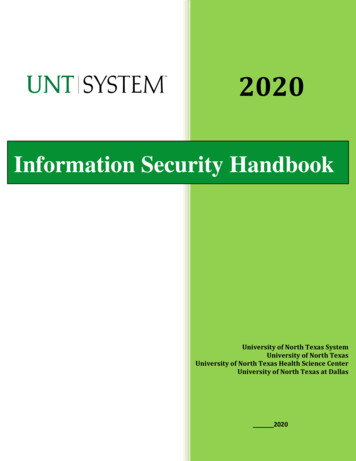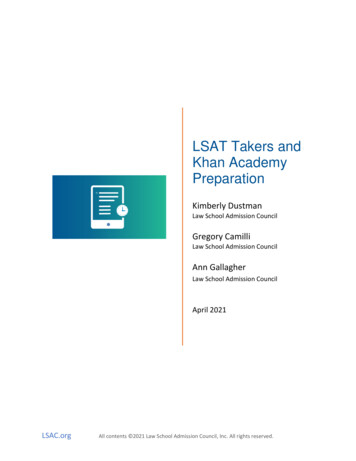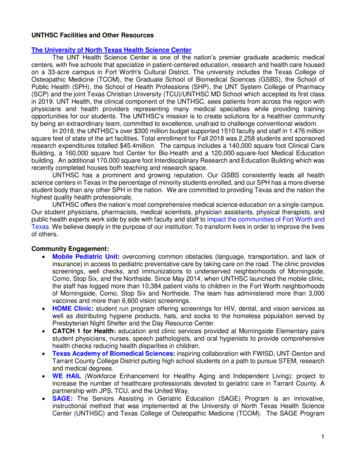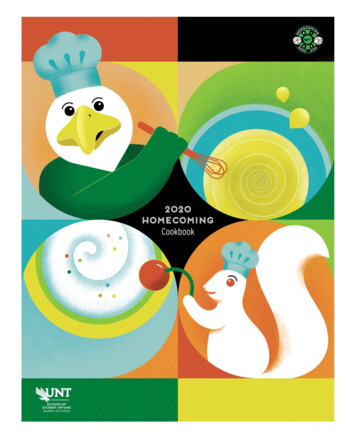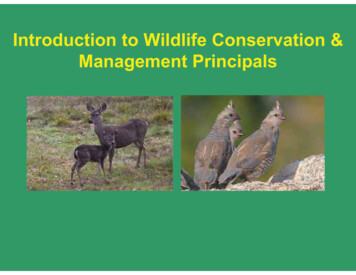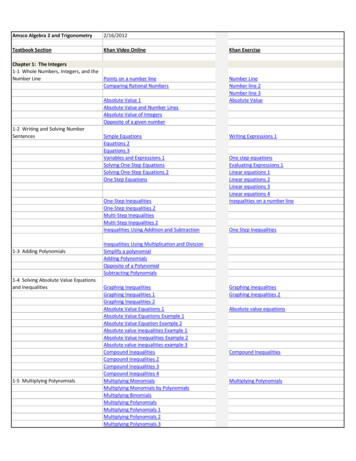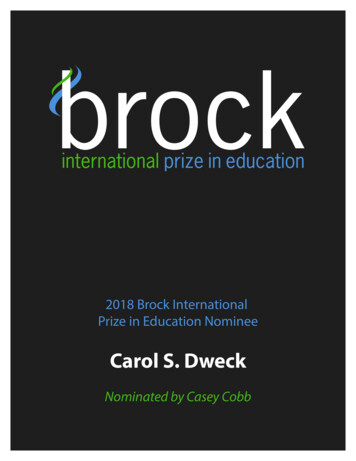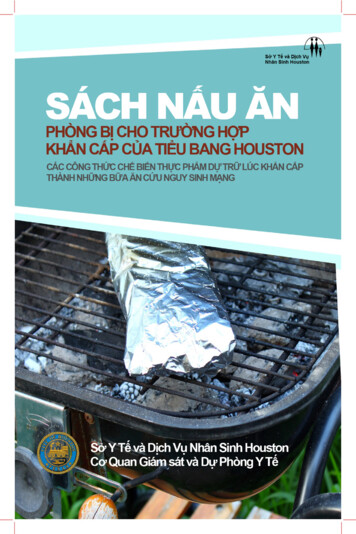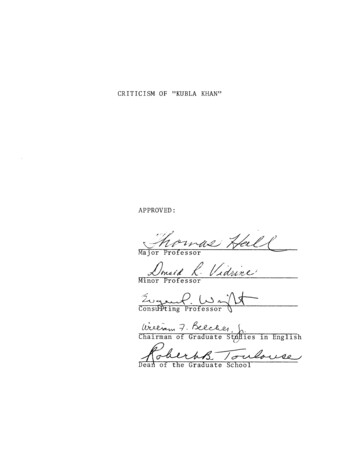
Transcription
CRITICISM OF "KUBLA KHAN"APPROVED:-.1Major Professor ? )hut*' f 'U Minor ProfessorConsisting Professor(Xx.7Chairman of Graduate StMies in EnglishDeaA of the Graduate School
Culpepper, James D. , Criticism of "Kubla Khan."Masterof Arts (English), December, 1971, 147 pp., bibliography,109 titles.The problem with which this study is concerned is analysis of the criticism of Samuel Taylor Coleridge's "Kubla Khan."This poem, one of the poet's most widely anthologized poems,has been the subject of forty-five articles.The poem hasalso been treated extensively in a number of books.The criticism of the poem is organized in accordancewith a suggestion made by Richard Gerber.This organizationof the criticism is the only known system that has been suggested.In this arrangement the criticism is divided intothree categories: psychological, literary, and archetypal.Acount of the forty-five articles by categories gives thefollowing results:psychological criticism, nineteen; liter-ary criticism, twenty-three; and archetypal criticism, three.The psychological criticism is concerned with the origins ofthe poem and the processes which produced it.The literaryapproach concentrates on the poem as a finished work of art.In this criticism the meaning, structure, or imagery may beanalyzed.The archetypal approach is concerned with thearchetypes and archetypal patterns which lie behind theimages of the poem.The psychological category is furtherdivided into criticism stressing unconscious composition,criticism stressing conscious composition, and criticism ofa general approach.
This organization of the criticism is outlined inChapter I.In this chapter the three kinds of criticism aredefined, and the early reviews of "Kubla Khan" are cited.The few comments which Coleridge himself made on the poem arealso included.Chapter II is devoted to a study of psycho-logical criticism.The criticism of John Livingston Lowes,J. B. Beer, and Elisabeth Schneider is studied in detail asmajor examples of the psychological approach.In Chapter IIIthe literary and archetypal approaches to the poem are examined.The conclusions are presented in Chapter IV.Criticism of the poem was slow to reflect the discoveryin 1934 of the Crewe Holograph MS., which revealed thatColeridge worked consciously on the surface of the poem inspite of his statement of unconscious composition in the preface of 1816.This fact is indicated by Coleridge's use ofthe word "Reverie" in the note in the Crewe MS., instead ofthe stronger "profound sleep" of the other prefatory note,and by subsequent alterations which are evident from a comparison of the Crewe MS. and the printed version of the fiftyfour line poem.This additional knowledge of the compositionof the poem eventually led to new interpretations.In boththe psychological and literary categories, a number of critics are in agreement that "Kubla Khan" is about the composition of poetry.The speaker is presumed to be a poet inthese interpretations, and the subject of this poet's discourse is the creative process.An interpretation such as
this one, however, is true only up to a certain point becauseof the complexity of the imagery.Psychological criticism has proved the most adequate.The psychological approach is responsible not only for thegreat achievements in the criticism of the poem, but also tosome extent for the lesser achievements of the other categories.The literary approach, with one or two exceptions,has been effective only in dealing with certain aspects ofthe poem such as the imagery.however, has improved greatly.Literary analysis of the poem,Finally, the contribution ofthe scarce archetypal criticism to knowledge of the poem isrelatively slight.criticism.There may be bases for more archetypal
CRITISICM OF "KUBLA KHAN"THESISPresented to the Graduate Council of theNorth Texas State University in PartialFulfillment of the RequirementsFor the Degree ofMASTER OF ARTSByJames D. Culpepper, B.A.Denton, TexasDecember, 1971
TABLE OF CONTENTSChapterI.II.PageINTRODUCTION1PSYCHOLOGICAL CRITICISM . . .9Psychological Criticism StressingUnconscious Composition11Psychological Criticism StressingConscious Composition . . .51Psychological Criticism of theGeneral Approach . . .III.LITERARY AND ARCHETYPAL CRITICISM'The Literary ApproachThe Archetypal ApproachIV.CONCLUSION. . . . ;BIBLIOGRAPHY-769394122132139in
CHAPTER IINTRODUCTIONThe importance of "Kubla Khan" is established by its rankas one of Samuel Taylor Coleridge's four major poems in termsof popularity, together with "The Rime of the Ancient Mariner,""Christabel," and "Dejection: An Ode."This popularity of"Kubla Khan" is attested by the fact that the poem has beenanthologized innumerable times.A count of the articles whichhave been located on the poem gives a grand total of fortyfive.Although the interest in the poem as reflected in theanthologies and articles reaches these proportions, no systematic study of the criticism, so far as is known, has everbeen attempted.The purpose of this paper, then., is to pro-vide such a survey.The only known schematization which hasbeen suggested for the criticism of the poem is that ofRichard Gerber, and in accordance with Gerber's suggestionthe criticism is divided into two principal categories:psychological criticism and' literary criticism.In additionto these two categories, however, Gerber suggests a thirdcategory of archetypal criticism, which is of less significance because of its infrequent occurrence. '-Richard Gerber, "Cybele, Kubla Khan, and Keats: An Essayon Imaginative Transmutation," English Studies, XLVI (October,1965), 370-371.
In describing the three kinds of .criticism, Gerber saysof the psychological approach that it "is concerned with theorigins and the processes which produced the poem."2Of theliterary approach he says that it "considers the poem as awork of art like any other work of art with no, or only a%minor, consideration of its strange origin."Gerber observesof the archetypal approach merely that it is the method usedby Maud Bodkin. According to Bodkin, her aim is to examineC. G. Jung's hypothesis of "the stirring in the reader'smind . . . of unconscious forces which he terms 'primordialimages,' or archetypes." Gerber states that there have been"two major examples" of psychological criticism, John Livingston Lowes and J. B. Beer, of whom he says:Lowes is concerned with the exotic verbal surfaceof the poem and considers the dream-process in asomewhat Lucretian or Lockean way as a chaoticwhirl of hooked atoms so that it is not surprisingthat he can only see the poem as a pointlessphantasmagoria and meaningless concatenation ofimages. Lowe's method may be called atomistic.Beer's method is the very opposite of Lowes's.2Ibid., p. 370. Ibid. Ibid., p. 371, and note.5C. G. Jung, "On the Relation of Analytical Psychology toPoetic Art," in Contributions to Analytical Psychology, translated by H. G. and C. F. Baynes (1928), as cited by MaudBodkin, Archetypal Patterns in Poetry: Psychological Studiesof Imagination (Lon on" 1934J7 p. 1.
He envisages an extremely detailed and complicatedColeridgean thought-structure which is realized orclothed in a number of images. While Lowes remainson the outside or surface of the poem Beer stepsbehind the poem into the realm of constitutive ideaswhich he sees in a strongly cabbalistic context.His method- might be called idealistic.&The forty-five articles of criticism on the poem includeevery article which has been uncovered through all availablemeans within certain limitations of time.A division of thesearticles according to the categories gives the following results:psychological criticism, nineteen; literary criti-cism, twenty-three; and archetypal criticism, three.Refer-ring to the great bulk of criticism on the poem, Gerber says:It is fairly safe to say that no poem in the Englishlanguage has provided more pages of comment per linethan 'Kubla Khan'. Even if we disregard the largevolume of separate articles it remains in an uniqueposition since it is the only 54-line poem to haveinspired three voluminous books of criticism. Gerber lists the three books as follows: Lowes's The Road toXanadu (New York, 1927), Elisabeth Schneider's Coleridge,Opium and Kubla Khan (Chicago, 1953), and J. B. Beer's ColeOridge the Visionary (London, 1959).Since Gerber's articlewas published, however, a fourth and a fifth, though perhapsnot as voluminous as the others, have been added to the list: Gerber, pp. 370-371.7Richard Gerber, "Keys to 'Kubla Khan,"' English Studies,XLIV (October, 1963), 322. Ibid., p. 322, n. 2.
Marshall Suther's Visions of Xanadu (New York, 1965) and Geoffrey Yarlott's Coleridgethe Abyssinian Maid (London, 1967).It may seem strange in retrospect that the early reviewsof "Kubla Khan" were so unfavorable. The Edinburgh Reviewdeclares of the volume Christabel in September, 1816:Upon the whole, we look upon this publication asone of the most notable pieces of impertinenceof which the press has lately been guilty; andone of- the boldest experiments that has yet beenmade upon the patience or understanding of thepublic. . . . The other productions of the LakeSchool have generally exhibited talents thrown awayupon subjects so mean, that no power of genius couldennoble them. . . . But even in the worst of them,if we except the White Doe of Mr. Wordsworth andsome of the laureate odes, there were always somegleams of feeling or of fancy. But the thing nowbefore us, is utterly destitute of value.Although the author has never been positively identified, JamesDykes Campbell remarks that this early reviewer of "KublaKhan" was believed to be William Hazlitt, who "did not thinkit so bad as Christabel, or 'mere raving1 like The Pains ofSleep." 11But Hazlitt is believed now to have been the re-viewer of the volume for the Examiner in June, 1816.In theSee David V. Erdman, "A New Discovery: The First Reviewof 'Christabel,'" Texas Studies in English, XXXVII (1958),53-54, for a summary of the early reviews of the volume ofpoems.10Edinburgh Review, Vol. XXVII (September, 1816). Edinburgh Review (1816), as cited by James Dykes Campbell,Poetical Works of Samuel Taylor Coleridge (London,1914), p. 593, n. 111. See Elisabeth W. Schneider, "Tom Mooreand the Edinburgh Review of Christabel," PMLA, LXXVII.(March,1962), 71-76, for a discussion on the identity of the unkown uthor; and also Arthur H. Nethercot, The Road to Tryermaine(Chicago, 1939), pp. 28 ff., for a different opinion as tothe reviewer's identity.
Examiner the reviewer states: "Kubla Khan, we think, onlyshows that Mr. Coleridge can write better nonsense verses thanany man in England.It is not a poem, but a musical composi-tion.Coleridge attributed the attacks of 1816 on both The13Statesman's Manual and Christabel to Hazlitt.But HenryCrabb Robinson notes in his Diary, on December 21, 1816,- thatColeridge "ascribes to Lamb the best ideas in Hazlitt'sarticles." ' Charles Lamb expresses his doubts about thepoem in a letter to Wordsworth, dated April 26, 1816:Coleridge is printing 'Christabel,' by Lord Byron'srecommendation to Murray, with what he calls avision, 'Kubla Khan,' which said vision he repeatsso enchantingly, that it irradiates and bringsheaven and elysian bowers into my parlor while hesings or says it; but there is an observation,'Never tell thy dreams,' and I am almost afraidthat 'Kubla Khan' is an owl that won't bear daylight.I fear lest it should be discovered by the lanternof typography and clear reducting no better thannonsense or no sense. Coleridge himself was strangely quiet about "Kubla Khan"beyond the few remarks he made in the prefatory note published William Hazlitt, "Mr. Coleridge's Christabel," in TheComplete Works of William Hazlitt, edited by P. P. Howe,Vol. XIX, 21 vols. (London, 1933), p. 34.13Thomas Middleton Raysor, editor, Coleridge's Miscel- laneous Criticism (Cambridge, 1936), p. 397, and n. 2.'14Henry Crabb Robinson, Diary, in ibid., p. 397. Charles Lamb, The Works of Charles Lamb, edited byThomas Noon Talfourd, Vol. 1, 3 vols. (New York, 1881), pp.253-254.
with the poem in 1816.Another note, found in the Creweholograph MS., was revealed by Alice D. Snyder in 1934. .This note reads:This fragment with a good deal more, notrecoverable, composed, in a sort of Reveriebrought on by two grains of Opium, taken tocheck a dysentery, at a Farm House betweenPorlock § Linton, a quarter of a mile fromCulbone Church, in the fall of the year, 1797.S. T. Coleridge" An unpublished note of November 3, 1810, reproduced inpart by Wylie Sypher, was believed by Ernest Hartley Coleridge to link the quarrel between Coleridge and Charles Lloydwith the "retirement" to the farm-house where the poem was18written.The note reads as follows:. . . on my side, patience, gentleness, and goodfor evil--yet this supernatural effort injured me-what I did not suffer to act on my mind, preyed onmy body--it prevented my finishing the Christabel-§ at the retirement between Linton and Porlock wasthe first occasion of my having recourse toopium. . . . Alice D. Snyder, "The Manuscript of 'Kubla Khan,"'Times Literary Supplement. August 2, 1934, p. 541. Compareh.H.W. Meyerstein, "A Manuscript of 'Kubla Khan,'" TimesLiterary Supplement, January 12, 1951, p. 21.17Wylie Sypher, "Coleridge's Somerset: A Byway to Xanadu,"Philological Quarterly, XVIII (October, 1939)-, 363. MeyerAbrams (The Milk of Paradise [Cambridge, 1934], p. 78, n.134)seems to have foretold Coleridge's use of the words "Opium"and "Reverie" in this prefatory note. Abrams says of the 1816preface: "In my opinion, 'sleep' is as ambiguous as 'anodyne.'Coleridge should have written 'opium revery,' which is adifferent thing from an actual dream." Patricia M. Adaircalled attention to Abrams' statement in The Waking Dream(London, 1967), p. 110.18Ernest Hartley. Coleridge, editor, The Complete PoeticalWorks of Samuel Taylor Coleridge, Vol. 1, 2 vols. (Oxford,1912) , p."795.
Finally in 1952, an entry, dated September 26, 1830, in themanuscript of Henry Nelson Coleridge's Table Talk of Samuel?0Taylor Coleridge, was made available.Morchard Bishop,using the entry in his effort to locate the farm-house of the"retirement," quotes this terse statement by Coleridge onthe composition of.the poem:"I wrote Kubla Khan in BrimstoneFarm between Porlock and Ilfracome--near Culbone.Critics of the twentieth century for the most part havelooked upon "Kubla Khan" with more favor than did the earlyreviewers, although modern critics have puzzled over Coleridge's strange silence about the poem.The criticism dealtwith in this study has been selected for its importance tothe categories.This, importance has been determined by thecontribution of the criticism to a particular category.Itwill be observed that the criticism has been organized roughlyaccording to importance and chronology.In this arrangementthe criticism of the past decade is considered last in eachclassification.For only too often critics build theirinterpretations on those of.earlier critics, and as a resultthere is not enough difference to warrant further space.Itis perhaps worth noting, however, that in the case of "KublaKhan" the diversity is more pronounced than the similarity.20Morchard Bishop, Times Literary Supplement, May 10,1957, p. 293. Ibid.
8Lowes's interpretation of the poem provided the impetus for agreat deal of psychological criticism through the nineteenfifties.first.Psychological criticism will therefore be considered
CHAPTER IIPSYCHOLOGICAL CRITICISMThe preponderance of psychological criticism is perhapsa result of the peculiar nature of "Kubla Khan."Coleridgebrought the psychological critics down on himself with hisprefatory note in the 1816 volume, in which the poem was firstpublished together with "Christabel" and "The Pains of Sleep."In the note he offered the poem to the reader "rather as apsychological curiosity, than on the ground of any supposedpoetic merits." Referring to himself in the third person,the poet tells how, in ill health, he "had retired to a lonelyfarm-house between Porlock and Linton, on the Exmoor confinesof Somerset and Devonshire."-2The note continues:In consequence of a slight' indisposition, an anodyne had been prescribed, from the effects of whichhe fell asleep in his chair at the moment that hewas reading the following sentence, or words of thesame substance, in 'Purchas's Pilgrimage': 'Herethe Khan Kubla commanded a palace to be built, anda stately garden thereunto. And thus ten miles offertile ground were inclosed with a wall.' The Authorcontinued for about three hours in a profound sleep," Samuel Taylor Coleridge, The Complete Poetical Works ofSamuel Taylor Coleridge, edited by Ernest Hartley Coleridge,Vol. I, 2 vols. (Oxford, 1912), p. 295.2Ibid., pp. 295-296.
10at least of the external senses, during which timehe has the most vivid confidence, that he could nothave composed less than from two to three hundredlines; if that, indeed can be called composition inwhich all the images rose up before him as things,with a parallel production of the correspondentexpressions, without any sensation or consciousnessof effort. "On awaking," Coleridge says, he "instantly and eagerly wrotedown the lines that are here preserved." Then he was inter-rupted "by a person on business from Porlock," and when hereturned to his room more than an hour later, he found that"with the exception of some eight or ten scattered lines andimages, all the rest had passed away like the images on thesurface of'a stream into which a stone has been cast, butalas-! without the after restoration of the latter!" Belief or disbelief in the prefatory note usually determines the.stand that a critic takes on whether the poemwas consciously or unconsciously composed.If the criticbelieves the note to be substantially true, the criticismis generally unconscious as pertains to the composition of .the poem.If, on the other hand, the critic doubts Cole-ridge's veracity in the note, his criticism tends to stressconscious composition.Another indication of. the critic'sposition is found in the sources for the poem. Ibid., p. 296.4Ibid.5Ibid.If the
11sources are more or less confined to those which might beexpected to have sunk to the unconscious level of Coleridge'smind, the interpretation is classified as unconscious.Forexample, the travel books which provided Lowes with most ofthe images of what was for him the dream would come underthis classification.But if the sources cited are contem-porary with the period when the poem was composed, or if theyare works which Coleridge might reasonably consult with aview toward writing the poem, then the interpretation isclassified as conscious.Examples of this classificationwould include the poems with an priental background in whichElisabeth Schneider found the origins of the poem.Psychological Criticism StressingUnconscious CompositionJohn Livingston Lowes, tracing the origins of "KublaKhan" to Coleridge's reading, developed the theory of "hookedatoms" in The Road to Xanadu.Lowes's book, one of the mostinfluential and important works of modern critical scholarship, deserves detailed scrutiny in this paper.But theemphasis will be centered on Lowes's contributions to psychological criticism.Lowes begins his long search for thehooked atoms with a string of suppositions: Elisabeth Schneiderj Coleridge, Opium and Kubla Khan(Chicago, 1953), p. 1.
12Suppose a subliminal reservoir thronged, as Coleridge's was thronged, with images which had flashedon the inner eye from the pages of innumerable books.Suppose these images to be fitted, as it were, withlinks which render possible indefinite combination.Suppose some powerful suggestion in the field ofconsciousness strikes down into this mass of imagesthus capable of all manner of conjunctions. Andsuppose that this time, when in response to thesummons the sleeping images flock up, with theirpotential associations, from the deeps --supposethat this time all conscious imaginative control isfor some reason in abeyance"! What, if all this wereso, would happen? Lowes asserts:"That hypothetical question fairly covers, Ithink, the case of 'Kubla Khan.'"8The "hooked-atom" theory,which was fundamental to Lowes's explanation of "the processeswhich-produced the poem," went back to Coleridge's association of ideas.Phrasing his question again, with thisfact in mind,. Lowes says:I propose, then, first of all to consider verybriefly, but more explicitly than we have hithertoconsidered them, Coleridge's association of ideas.'Reprefsentons-nous,' says Henry Poincare' in thatweighty account of his own unconscious processeswhich I have already quoted--'representons-nous leselements futurs de-nos combinaisons comme, quel quechose de semblable aux atomes crochus d' EpicureHow did Coleridge's 'hooked atoms'--those impressions John Livingston Lowes, The Road to Xanadu (New York,1927), p. 343.';8Ibid. Richard Gerber, "Cybele, Kubla Khan, and Keats: An Essayon Imaginative Transmutation," English Studies, XLVI (October,1965), 370."l Henri Poincar§, Science et M§thode (Paris, 1908), p. 60,as cited by Lowes, p. 344.
13and images equipped, in his own phrase, with 'hooksand eyes of the memory' - --behave? That is the firstquestion which demands an answer.Before considering Lowes's answer to this question, itshould be helpful to-return to Coleridge's statement on theassociation of ideas which Lowes quoted earlier, one that isfundamental to Lowes's own theory of unconscious composition.Lowes observes, in regard to this statement on the association of ideas, that "it is conceivable' that the imagesmentioned by Coleridge "might so coexist thereafter in thebrain that no one of them could emerge without trailing withit the blended phantasms of the rest."-'-3Thus the statementis related to Lowes's theory of "hooked atoms" and, subsequently, to his theory of the processes of poetic composition.The statement, as quoted by Lowes, is as follows:'Seeing "a mackerel,' says' Coleridge in an attemptto elucidate the association of ideas, 'it mayhappen, that I immediately think of gooseberries,because I"at the same time ate mackerel with gooseberries as the sauce. The first* syllable of thelatter word, being that which had coexisted with theimage of the bird so called, I may then think of agoose. In the next moment the image of a swan mayarise before me, though I had never seen the twobirds together.- Samuel Taylor Coleridge, Eiographia Epistolaris, editedby A. Turnbull (London, 1911), 11, 59, as cited by Lowes, p. 344,l Lowes, pp. 343-344.13Ibid., p. 91. Samuel Taylor Coleridge, Biographia Literaria, editedby J. Shawcross, 2 vols. (Oxford, 1907) Tl, p. 86, as citedby Lowes, p. 91.
14Thus, it will be observed that the sources Lowes could uncoverfor the poem would give him all the material he needs to showhow it was composed.In answer to the question he himself has raised, Lowescites four or five examples from Coleridge on the associationof ideas, thus establishing the basis for his interpretation,one which illustrates perfectly the category of psychologicalcriticism.The fact that his interpretation does illustratethe category so well should not be surprising since Lowespointed the way, as it were, for much of the criticism thatfollowed.One or two of the examples that Lowes cites on theassociation of ideas should suffice to answer his questionfor the purposes of this paper.The "singular instance ofsuch amalgamation" is related to Coleridge's distinctionbetween imagination and fancy.15it will be necessary torecall the distinction that Coleridge made between the twoin order to understand fully Lowes ? s example.Imagination iseither "primary" or "secondary":The primary Imagination I hold to be the livingpower and prime agent of all human perception,and as a repetition in the finite mind of theeternal act of creation in the infinite I AM.The secondary Imagination I consider as an echoof the former, co-existing with the consciouswill, yet still as identical with the primaryin the kind of its agency. . . .It dissolves,diffuses dissipates, in order to re-create: orwhere this process is rendered impossible, yetstill at all events it struggles to idealizel Lowes, p. 346,
15and to unify. It is essentially vital, even asall objects (as objects) are essentially fixedand dead.16In contrast, fancy "has no other counters to play with butfixities and definites.The fancy is indeed no other thana mode of memory emancipated from the order to time andspace, "I?First, in his example from Coleridge on the associationof ideas, Lowes quotes a portion of Crabb Robinson's Diary,dated November 15, 1810, in which Coleridge uses Otway's"seas of milk and ships of amber" as an illustration of "oneof his favourite notions . . .of a correspondence betweenfancy and imagination on the one hand, and delirium and18mania on the other.".The distinction appears again in theBiographia LiterarJLa in the familiar passage comparing Miltonand Cowley: .l Samuel Taylor Coleridge, Biographia Literaria, Vol.Ill of The Complete Works of Samuel Taylor Coleridge, editedby W. G. T. Shedd, 7 vols. TNew York, 1884) , pp. 363-364.I. A. Richards, in Coleridge on Imagination (Bloomington,1960), pp. 58-59, related the primary Imagination to thenormal, everyday world of the senses, and the secondaryImagination to the higher values of civilized life. JamesV. Baker, appraising the theory in The Sacred River: Coleridge 's Theory of the Imagination (Baton Rouge, 1957), pp.212 ff., observes, p. 217 : "The weakness of Coleridge'stheory is using 'fancy' as a name for the associative powerand assuming that the associative power is 'mechanical.'" Coleridge, Biographia Literaria (1884), III, 364. Crabb Robinson, Diary (London, 1869), I, 306, as citedby Lowes, p. 346.
16Milton had a highly imaginative, Cowley a veryfanciful mind. If therefore I should succeed inestablishing the actual existences of two facultiesgenerally different, the nomenclature would be atonce determined. To the faculty by which I hadcharacterized Milton, we should confine the termimagination; while the other would be contradistinguished as fancy. Now were it once fullyascertained, that this division is no less groundedin nature, than that of delirium from mania, orOtway's'Lutes, lobsters, seas of milk,.and ships ofamber,'from Shakespear's'What! have his daughters brought him to thispass?' . . .the theory of the fine arts, and of poetry in particular, could not, I thought, but derive someadditional and important light. Lowes continues: "Now Otway's line is taken from Venice Pre7Dserved, or A Plot Discovered,a play the sub-title of which,with its veiled reference to the contemporary 'Popish Plot,'had given Coleridge as early as 1795 the title for his ownpolitical pamphlet, The Plot D i s c o v e r e d . C o l e r i d g e hadmisquoted the line, however. Lowes says thatOtway wrote:Lutes, laurels, seas of milk, and ships ofamber. '- Coleridge, Biographia Literaria (1907), I, 62 as citedby Lowes, pp. 346-347.2 Act v, sc. ii, last line. Lowes, p. 347.
17The line as Coleridge recalled it isLutes, lobsters, seas of milk, and ships ofamBer.How did the lobsters get into the list? z zThe answer to the question about the lobsters is to befound in another of Coleridge's illustrations of fancy appearing in Table Talk for June 23, 1834, in which he quotesa passage from Hudibras:'The sun had long since in the lapOf Thetis taken out his nap,And like a lobster boyl'd, the mornFrom black" to red began to t u r n . ' "Lowes admitting that i834 was the earliest known year in whichColeridge used the lines from Hudibras, "whereas the lobstersslipped into Otway's line nineteen years e a r l i e r , t h e ncites another passage, this time from Frederick Martens,about a crawfish shaped like a lute.And he concludes: "Iam not deeply concerned to decide whether Butler or Martensprovided the channel through which the lobsters floated intoseas of m i l k . " The important fact was that "a new combi7 f\nation was effected."formed.A dream in miniature has beenThe example is important because it shows how Lowesexplained the composition of the poem, for in both the Ibid., italics Lowes's. Hereafter in Lowes's criticism all italics will be his unless specified otherwise. Hudibras, Part II, Canto ii, 11. 29-32, as cited byLowes, p. 347.24Lowes, p. 348. I b i d . , p. 349,26Ibid.
18illustration of fancy and the poem the creative force-Coleridge's unconscious-- is the same.Thus, Lowes's expla*-nation of the creative processes stresses the unconscious.Lowes recalled similar combinations from his study of"The Ancient Mariner" in order to clarify the hooked atoms.He states that "the point involved is fundamental to ourunderstanding of the genesis of 'Kubla Khan1--so fundamental,indeed, that the obvious course of referring back to theearlier pages will scarcely serve our ends."27The hookedatoms are in fact the backbone, as it were, of Lowes's theoryof the creation of the poem, and for that reason they requirespace here.Lowes observes that two passages, one fromFrederick Martens' Voyage into Spitzbergen and Greenland(London, 1694), and the other that of Father Bourzes in thePhilosophical Transactions, coalesced for this memorandumwhich Coleridge made in the Notebook:Sun paints rainbows on the vast wavesduring snow storms in theCape.28Lowes points out that "in the narrative which inspired thenote nothing whatever is said of the size of the waves, nor2 7 Ibid.2 Samuel Taylor Coleridge, Notebook, Add. MSS. 27901, fol.76a; and also "S.T. Coleridges Notizbuch aus den Jahren 17951798," in Herrig's Archiv fur das Studium der Neueren Sprachenund Literaturen, translated by Alois Brandl, XCVII (T896), p.268, both as cited by Lowes, p. 350. See also Samuel TaylorColeridge, The Notebooks of Samuel Taylor Coleridge, edited byKathleen CoFurn, Vol. I, Part l TNew York, 1957), No. 262
ary criticism, twenty-three; and archetypal criticism, three. The psychological criticism is concerned with the origins of the poem and the processes which produced it. The literary approach concentrates on the poem as a finished work of art. In this criticism the meaning, structure, or imagery may be analyzed.
